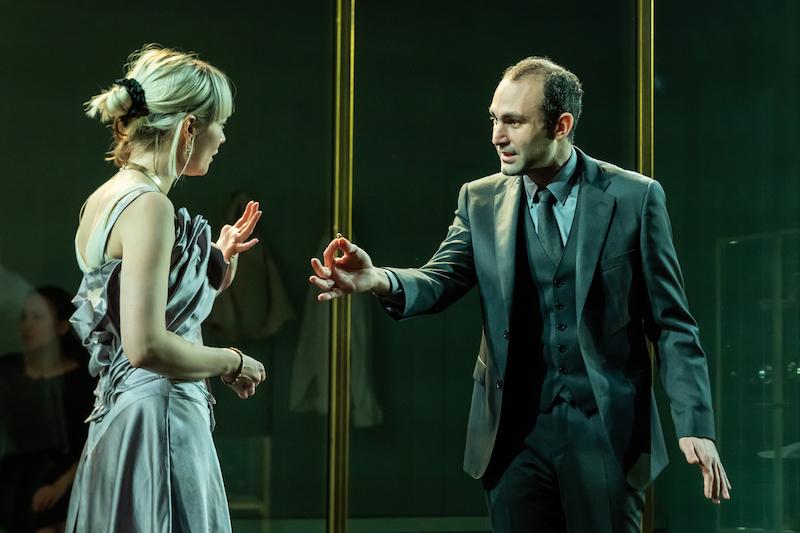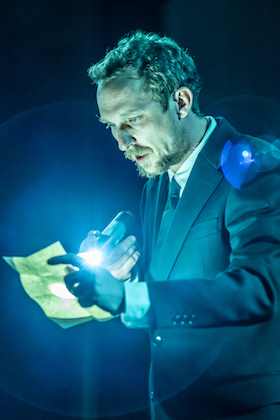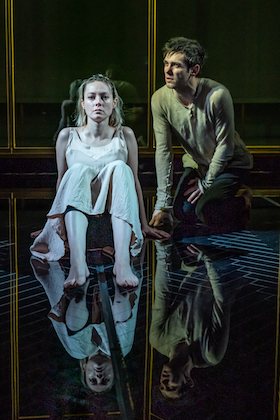The Duchess of Malfi, Almeida Theatre review - a radically original perspective on Webster's tragedy | reviews, news & interviews
The Duchess of Malfi, Almeida Theatre review - a radically original perspective on Webster's tragedy
The Duchess of Malfi, Almeida Theatre review - a radically original perspective on Webster's tragedy
Rebecca Frecknall directs a production which ultimately finds its heart

This play can be a challenge for modern audiences: a woman who is ostensibly in a position of power, "a prince" in Renaissance terms, is nevertheless constrained by social expectations and a prisoner of the will of her overbearing brothers. A widow, she defies them to marry her steward Antonio in secret and tragedy ensues.
Rebecca Frecknall attacks the text boldly, judiciously cutting it and placing the action on a set (designed by Chloe Lamford) which consists mainly of a wide glass box. On each side, a glass case holds props and there are minimal suggestions of rooms just "off" to which actors sometimes repair. This could scarcely be more different from the circumstances of the play's first performances, in 1614, at the intimate candle-lit Blackfriars Theatre (although it was later played outdoors at the less rarefied Globe too). There was the opportunity to get some idea what that earliest experience was like in 2014 when Dominic Dromgoole directed Gemma Arterton in the lead role at the Sam Wanamaker Playhouse, making the most of the suggestive power of darkness. Frecknall's intentions are different.
 To begin with, the abstraction which she used to such brilliant effect in Tennessee Williams' Summer and Smoke last year threatens to provide a demonstration of the themes of the play rather than a way into it. A powerful woman, simultaneously on show and imprisoned, the necessary qualities of a leader, the contrast between reality and subterfuge and of the parallels between theatre and the real world - these ideas are brought out clearly. But the emotional intensity found in the Williams is lacking here - it seems deliberately. Scenes are labelled in Brechtian fashion, in lights: "A Birth", "A Trap" etc. And there are a few too many slo-mo moves, for my taste, by actors not directly involved in a scene. Nevertheless, all the characters are allowed a degree of humanity and after the interval and the sign "A Murder" it somehow all pays off, speeding to the horror of the final scene which culminates in the slow piling up of bodies to the heart-stoppingly mournful strains of "Dido's Lament".
To begin with, the abstraction which she used to such brilliant effect in Tennessee Williams' Summer and Smoke last year threatens to provide a demonstration of the themes of the play rather than a way into it. A powerful woman, simultaneously on show and imprisoned, the necessary qualities of a leader, the contrast between reality and subterfuge and of the parallels between theatre and the real world - these ideas are brought out clearly. But the emotional intensity found in the Williams is lacking here - it seems deliberately. Scenes are labelled in Brechtian fashion, in lights: "A Birth", "A Trap" etc. And there are a few too many slo-mo moves, for my taste, by actors not directly involved in a scene. Nevertheless, all the characters are allowed a degree of humanity and after the interval and the sign "A Murder" it somehow all pays off, speeding to the horror of the final scene which culminates in the slow piling up of bodies to the heart-stoppingly mournful strains of "Dido's Lament".
Frecknall's editing removes some of the most difficult elements for a modern audience, including the performing madmen and the death of Julia, the Cardinal's mistress, by poisoned Bible.The Duchess's lack of reference to her children at her death is perhaps surprising, however. The difficult waxworks scene works because it plays into Frecknall's examination of the levels of reality and pretence: as is usual, a real actor plays a waxwork which the Duchess takes to be her dead husband, but this time the audience sees the "waxwork" leave the stage.
 Neglected for many years, The Duchess of Malfi, was rediscovered at the end of the Second World War. In her illuminating programme essay, Emma Smith points out that it was reviewed alongside the first photographs of the death camps. Webster's view of human depravity no longer seemed far-fetched. Both Shaw and George Henry Lewes (partner of George Eliot) had dismissively invoked the popular waxworks of murderers at Mme Tussaud's when referring to his work. More recently, the wickedly grinning boy in Shakespeare in Love feeding live mice to a cat, encapsulates a notion of him as a pedlar of horror. T S Eliot's more appreciative description: "Webster was much possessed by death/And saw the skull beneath the skin" suits more with our times. Frecknall avoids melodrama; instead, except in the domestic scenes in which the Duchess woos Antonio (an unassuming Khalid Abdalla) or plays with her family, an air of sadness prevails.
Neglected for many years, The Duchess of Malfi, was rediscovered at the end of the Second World War. In her illuminating programme essay, Emma Smith points out that it was reviewed alongside the first photographs of the death camps. Webster's view of human depravity no longer seemed far-fetched. Both Shaw and George Henry Lewes (partner of George Eliot) had dismissively invoked the popular waxworks of murderers at Mme Tussaud's when referring to his work. More recently, the wickedly grinning boy in Shakespeare in Love feeding live mice to a cat, encapsulates a notion of him as a pedlar of horror. T S Eliot's more appreciative description: "Webster was much possessed by death/And saw the skull beneath the skin" suits more with our times. Frecknall avoids melodrama; instead, except in the domestic scenes in which the Duchess woos Antonio (an unassuming Khalid Abdalla) or plays with her family, an air of sadness prevails.
Central to a fine ensemble are two outstanding performances, that of Lydia Wilson (nominated for an Olivier here for her Kate in Charles III) in the name part (pictured above right with Jack Riddiford) and Leo Bill as Bosola. Wilson makes her Duchess authoritative but affectionate, even with Duke Ferdinand and the Cardinal her two brothers, desperate when faced with what is apparently her husband's corpse, but still stoical in death. The line "I am Duchess of Malfi still" is a reclaiming of herself rather than defiance of her murderer. Bill - given the opening speech here - is sensational, finding every nuance of a complex character, disaffected by his lack of status, a cunning spy for Ferdinand (Jack Riddiford early hinting at instability), a sinister killer and then longing to save Antonio while hopelessly seeking redemption.
Frecknall makes sure that women are central throughout. In those final, emotional moments, the bodies are all male, but the music is the lament of a woman betrayed. Watching silently, behind the glass wall, are the dead figures of the Duchess herself, her murdered servant Cariola and the Cardinal's poisoned mistress, Julia. And, poignantly, the last figure on stage is not the Duchess' son hoping to reclaim his inheritance, but her young daughter, alone, surveying a scene of death and devastation.
rating
Explore topics
Share this article
The future of Arts Journalism
You can stop theartsdesk.com closing!
We urgently need financing to survive. Our fundraising drive has thus far raised £49,000 but we need to reach £100,000 or we will be forced to close. Please contribute here: https://gofund.me/c3f6033d
And if you can forward this information to anyone who might assist, we’d be grateful.

Subscribe to theartsdesk.com
Thank you for continuing to read our work on theartsdesk.com. For unlimited access to every article in its entirety, including our archive of more than 15,000 pieces, we're asking for £5 per month or £40 per year. We feel it's a very good deal, and hope you do too.
To take a subscription now simply click here.
And if you're looking for that extra gift for a friend or family member, why not treat them to a theartsdesk.com gift subscription?
more Theatre
 Ragdoll, Jermyn Street Theatre review - compelling and emotionally truthful
Katherine Moar returns with a Patty Hearst-inspired follow up to her debut hit 'Farm Hall'
Ragdoll, Jermyn Street Theatre review - compelling and emotionally truthful
Katherine Moar returns with a Patty Hearst-inspired follow up to her debut hit 'Farm Hall'
 Troilus and Cressida, Globe Theatre review - a 'problem play' with added problems
Raucous and carnivalesque, but also ugly and incomprehensible
Troilus and Cressida, Globe Theatre review - a 'problem play' with added problems
Raucous and carnivalesque, but also ugly and incomprehensible
 Clarkston, Trafalgar Theatre review - two lads on a road to nowhere
Netflix star, Joe Locke, is the selling point of a production that needs one
Clarkston, Trafalgar Theatre review - two lads on a road to nowhere
Netflix star, Joe Locke, is the selling point of a production that needs one
 Ghost Stories, Peacock Theatre review - spirited staging but short on scares
Impressive spectacle saves an ageing show in an unsuitable venue
Ghost Stories, Peacock Theatre review - spirited staging but short on scares
Impressive spectacle saves an ageing show in an unsuitable venue
 Hamlet, National Theatre review - turning tragedy to comedy is no joke
Hiran Abeyeskera’s childlike prince falls flat in a mixed production
Hamlet, National Theatre review - turning tragedy to comedy is no joke
Hiran Abeyeskera’s childlike prince falls flat in a mixed production
 Rohtko, Barbican review - postmodern meditation on fake and authentic art is less than the sum of its parts
Łukasz Twarkowski's production dazzles without illuminating
Rohtko, Barbican review - postmodern meditation on fake and authentic art is less than the sum of its parts
Łukasz Twarkowski's production dazzles without illuminating
 Lee, Park Theatre review - Lee Krasner looks back on her life as an artist
Informative and interesting, the play's format limits its potential
Lee, Park Theatre review - Lee Krasner looks back on her life as an artist
Informative and interesting, the play's format limits its potential
 Measure for Measure, RSC, Stratford review - 'problem play' has no problem with relevance
Shakespeare, in this adaptation, is at his most perceptive
Measure for Measure, RSC, Stratford review - 'problem play' has no problem with relevance
Shakespeare, in this adaptation, is at his most perceptive
 The Importance of Being Earnest, Noël Coward Theatre review - dazzling and delightful queer fest
West End transfer of National Theatre hit stars Stephen Fry and Olly Alexander
The Importance of Being Earnest, Noël Coward Theatre review - dazzling and delightful queer fest
West End transfer of National Theatre hit stars Stephen Fry and Olly Alexander
 Get Down Tonight, Charing Cross Theatre review - glitz and hits from the 70s
If you love the songs of KC and the Sunshine Band, Please Do Go!
Get Down Tonight, Charing Cross Theatre review - glitz and hits from the 70s
If you love the songs of KC and the Sunshine Band, Please Do Go!
 Punch, Apollo Theatre review - powerful play about the strength of redemption
James Graham's play transfixes the audience at every stage
Punch, Apollo Theatre review - powerful play about the strength of redemption
James Graham's play transfixes the audience at every stage
 The Billionaire Inside Your Head, Hampstead Theatre review - a map of a man with OCD
Will Lord's promising debut burdens a fine cast with too much dialogue
The Billionaire Inside Your Head, Hampstead Theatre review - a map of a man with OCD
Will Lord's promising debut burdens a fine cast with too much dialogue

Add comment